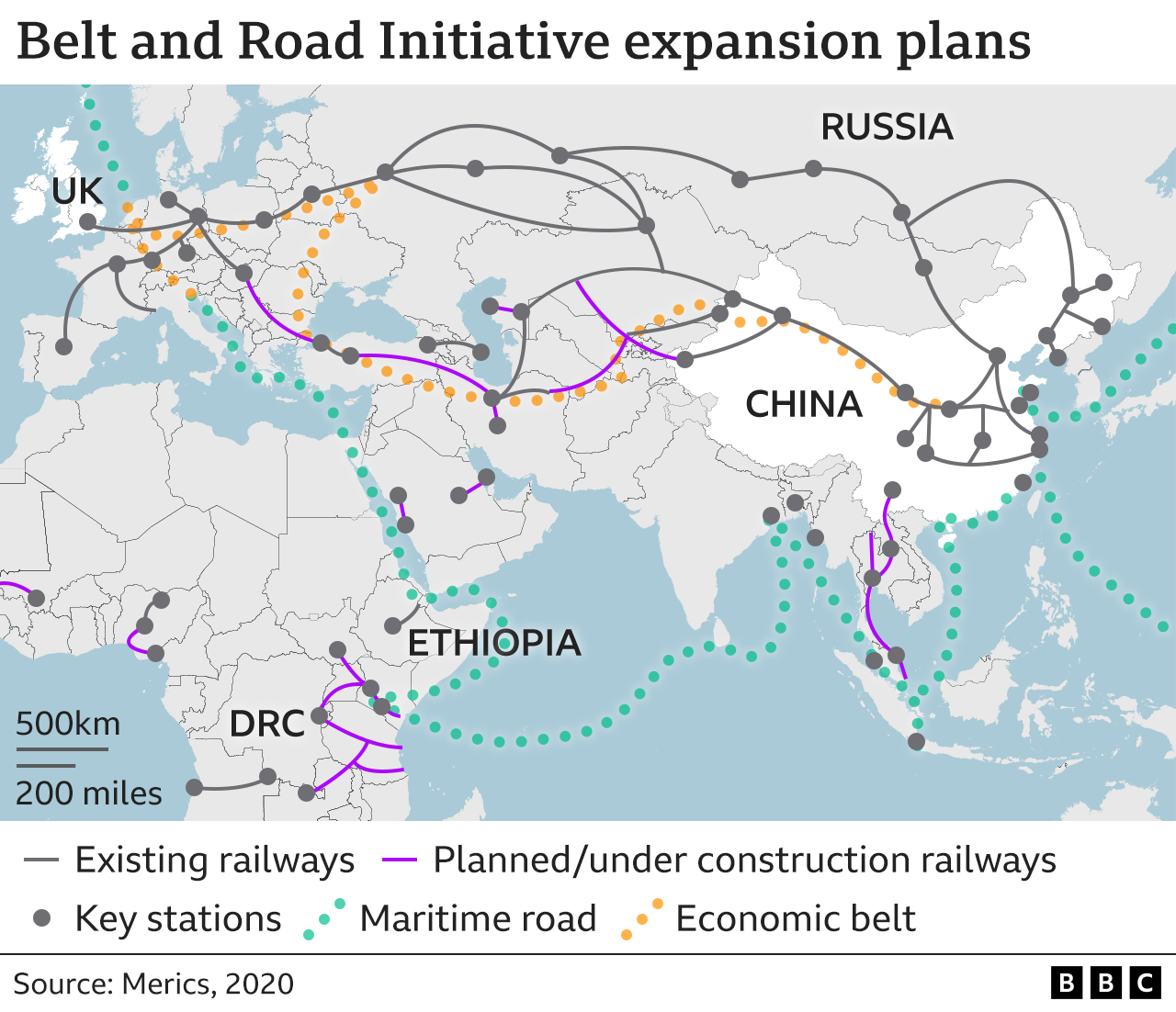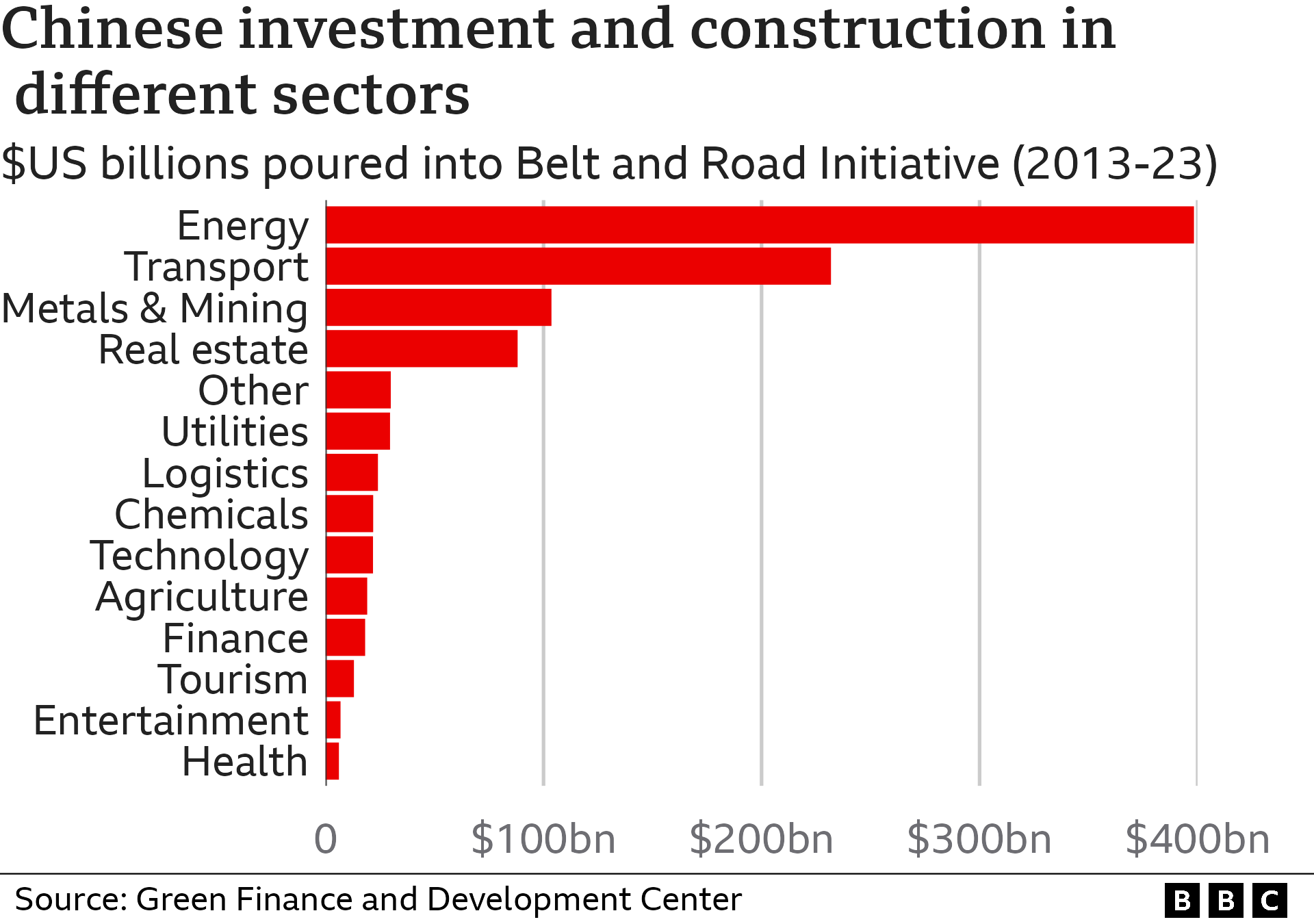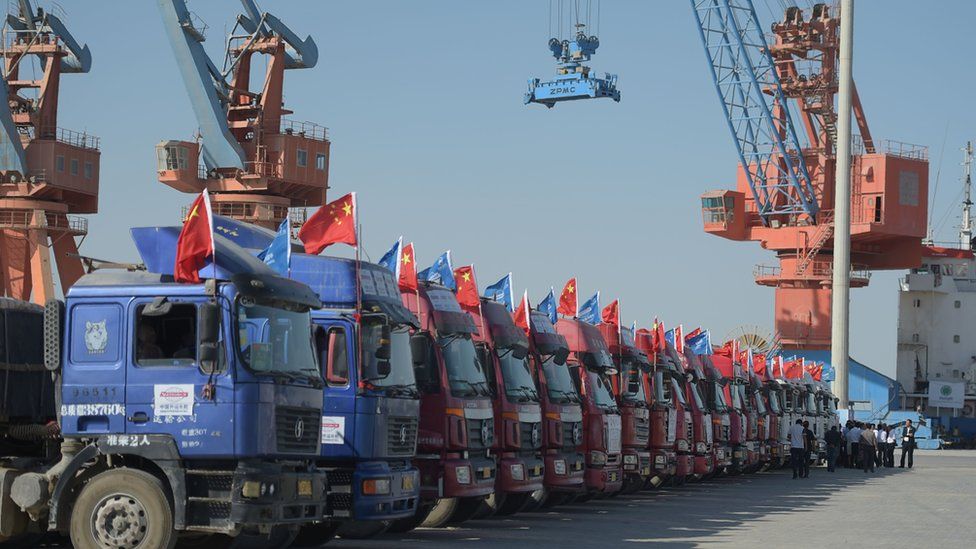This week, China is throwing a huge party to celebrate one of its biggest experiments in engaging with the world: its Belt and Road Initiative (BRI).
Officials and leaders from all over the globe are in Beijing to attend a high-level summit marking the BRI's 10th anniversary. Participants expected to show up range from Vladimir Putin to the Taliban. Chinese media is awash with coverage of the BRI's achievements, including a six-part documentary on state TV.
A signature policy of President Xi Jinping, the BRI is aimed at stitching China closer to the world through investments and infrastructure projects. With an unprecedented glut of cash pumped into nearly 150 countries, China boasts it has transformed the world - and it is not wrong.
But Beijing's massive gamble hasn't entirely gone the way it had hoped. Was it worth it?
From the moment the BRI was unveiled in 2013 with comparisons to the ancient Silk Road, it was clear China had sprawling ambitions.
"Belt" refers to overland routes connecting China to Europe through Central Asia, as well as to South Asia and South East Asia; while "Road" denotes a maritime network linking China to major ports through Asia to Africa and Europe.
It started off with heavy state-driven investment into hard infrastructure abroad. Most of the estimated $1tn (£820bn) has been poured into energy and transport projects, such as power plants and railways.

Beijing touted this as an economic win-win - it told other countries these investments would stimulate development, while at home it sold the BRI as a way to help Chinese companies, boost the economy and burnish the country's reputation.
It had limited success in meeting some goals, such as internationalising the yuan and solving Chinese companies' overcapacity.
But China reaped a huge economic benefit in trade. A slew of agreements brought access to more resources such as oil, gas and minerals, especially as the BRI's focus widened to include Africa, South America and the Middle East. About $19.1tn of goods were traded between China and BRI countries in the past decade.
"It's about Chinese state-owned enterprises going abroad... to help facilitate the flow of resources that China needs," said Jacob Gunter, a senior analyst at the Mercator Institute for China Studies. "It's also about expanding and developing export markets as alternatives to the liberal developed world."
This diversification has become crucial at a time when China faces greater tensions with the West and their allies.
Take soybeans for example. China, the world's biggest importer, used to rely heavily on the US for supplies. But a tariff war with Washington forced Beijing to turn to South American sources, especially Brazil, estimated to be the region's largest recipient of BRI funding.
Gas pipelines from Central Asia and Russia - and oil imports from Russia, Iraq, Brazil and Oman - have reduced Chinese dependence on Japan, South Korea and the US, according to the International Institute for Strategic Studies (IISS).

Having become the lender of first resort for many low or middle income countries through the BRI, China is now the world's biggest international creditor.
The true scale of the debt - thought to be at least hundreds of billions of dollars - is unknown because many of the loan agreements are shrouded in secrecy.
Now, from Sri Lanka and the Maldives to Laos and Kenya, countries are struggling with BRI debt. This puts the Chinese government in a tight spot.
A real estate crisis and liberal borrowing by local governments has already created a "debt bomb" domestically - it's estimated to run into trillions of dollars. A sluggish post-Covid economy and record youth unemployment have not helped.
China has restructured BRI loans, extended deadlines and forked out an estimated $240bn to help borrowers make payments on time. But it has refused to cancel the debt.
"For China to simultaneously engage in debt write-downs overseas while domestic economic issues are not fully resolved - it will be politically challenging internally to promote that," said Christoph Nedopil, founding director of the Green Finance and Development Center (GFDC), which tracks BRI spending.
This has marred Beijing's reputation. Some critics accuse China of engaging in "debt trap diplomacy" by luring poorer countries to sign up for expensive projects so that Beijing could eventually seize control of assets put up as collateral. This was the US' accusation over the controversial Hambantota port project in Sri Lanka.
Many analysts argue there is little evidence of this, but it has heightened fears that Beijing is using the BRI to undermine others' sovereignty.
China has also been criticised over its so-called "hidden debts" - governments don't know how exposed their borrowing institutions are, which makes it difficult for countries to weigh up the BRI's costs and benefits.

Over the years BRI projects have also been accused of creating wasteful "white elephants", fuelling local corruption, exacerbating environmental problems, exploiting workers, and failing to live up to promises of bringing jobs and prosperity to local communities.
One recent study by research lab Aid Data found more than a third of the projects face such problems. A growing backlash has prompted some countries like Malaysia and Tanzania to cancel BRI deals.

Read other articles in our series marking 10 years of BRI:

"Poor risk management and a lack of attention to detail and cohesion" from Chinese lenders and companies are partly to blame, according to the Council on Foreign Relations.
But other observers point out the borrowing countries are also to blame, like in the Hambantota case which was partly caused by Sri Lanka's own financial mismanagement.
They also say China gives resources with fewer strings attached, which is less onerous than offers from global lenders or the West.
"China shows up with a 'one-stop shop' approach: 'Here are our banks and companies and we do everything from start to finish, and if you sign today we will finish that railway, and it will be done in time just as you campaign for your next election'," pointed out Mr Gunter.
"It's a huge selling point to say that you can do it in one to three years with very little paperwork. Maybe it'll be a bit dirty and there may be labour rights violations, but your railway will be done."
Yet China has met one of its biggest goals - extending its influence.
It is not just through railways and highways that China has created connections. Beijing projects soft power and positions itself as a leader in the Global South, paying for thousands of Chinese university scholarships, cultural exchange programmes and Confucius Institutes. The expansion of the Brics trading bloc too has been credited to China.
Pew Research found that in the past decade many middle-income countries have increasingly favourable attitudes towards China, including Mexico, Argentina, South Africa, Kenya and Nigeria.

Mr Gunter noted that increasingly, countries in the Global South do not wish to choose sides in the US-China rivalry. "China hasn't flipped many countries from a Western orientation, but the fact it has moved the needle to a middle ground - that is already a huge diplomatic victory for Beijing," he said.
But observers have also raised concerns of possible economic coercion, where foreign governments feel pressured to follow Beijing's agenda or risk China pulling out investment.
One Aid Data study of Chinese state-owned entities' loans to foreign governments found contract clauses that "potentially allow the lenders to influence debtors' domestic and foreign policies".
In the UN, China has "corralled other states into temporary coalitions" to oppose measures critical of Beijing, while participation in the BRI has led several EU members to block or water down policies critical of China, pointed out the IISS.
The think tank also said the BRI has become one of China's "main instruments" in its diplomatic isolation of Taiwan. Many nations that have shifted recognition from Taiwan to China in the past decade are BRI funding recipients, it noted.
In South East Asia, Cambodia has consistently resisted condemnation of China's actions in the South China Sea, while Laos and Thailand have been criticised for arresting or allowing the abduction of Chinese activists wanted by Beijing.
China now recognises some things need to change.
Beijing preaches the mantra of "small and beautiful" where, through low-investment, high-yield projects, the BRI can have more relevance.
Examples given by state media include bamboo and rattan-weaving programmes in Liberia, biogas technology projects in Tonga and Samoa, and promoting mushroom-growing technology in Fiji, Papua New Guinea and Rwanda.
China has also announced a new "digital silk road" focused on telecommunication and digital infrastructure. Analysts say this would be a more sustainable stream of profits for Chinese companies, while lessening the impact of Western bans on Chinese 5G equipment.
With this new strategy, China has cut down financing. It has imposed limits on external lending by Chinese banks, and investment deals are now nearly 50% smaller than they were five years ago, according to a GFDC analysis. It has also moved away from being the only creditor in the BRI, and started a platform where other countries can lend money.
But Beijing has even grander plans for the BRI, which it now touts as the foundation of "the global community of shared future".
In two white papers released this month, Beijing said its form of globalisation would be fairer, more inclusive and less judgmental than the one led by "hegemonic" Western powers which seek a "zero-sum game".
"The BRI is a public road open to all, not a private path owned by any single party," it said. Far from seeking domination as critics say, China claimed it is "helping others to succeed while seeking our own success".
The view from China is that "now globalisation is in danger. The West, in the name of 'de-risking', is actually 'de-China-risking'," said Wang Yiwei, a professor who studies the BRI at Renmin University of China. The main challenge "is how can the BRI build mutual connectivity and avoid a new Cold War".
Beijing's trillion-dollar experiment has created a powerful tool to wield influence. But the question is whether the world wants a Chinese-led world order.
© OfficialAffairs